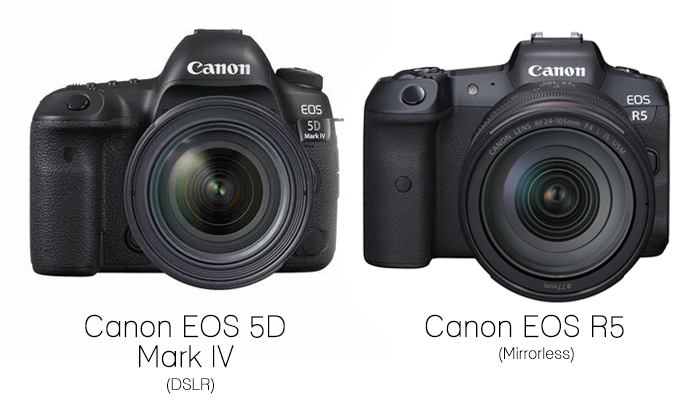DSLR versus Mirrorless – Which Camera Is Right For You?
When the very first digital cameras came out back in the mid 1990s, they were initially limited to compact, point-and-shoot style cameras. It took a while for professional-style film SLR (single lens reflex) cameras to make the transition to digital.
The very first DSLR (digital single lens reflex) cameras featured a similar mechanical design to their film predecessors, using a mirror system to reflect light onto the camera sensor.
Early models were heavy and clunky and often not very user-friendly. Over the years, technology has evolved at a rapid pace and the DSLR cameras of today are now far smaller and more streamlined that their early counterparts.
And it’s not just the DSLR that has benefitted from these technological advances. The constant push for progress – and for devices which are smaller, faster and packed with even more features – has resulted in a whole new generation of digital camera technology, one which ditches the traditional mirror system in favour of a more compact mirorrless design.
So now, when it comes to choosing a camera with full manual mode, you have the choice between a DSLR and a mirrorless camera. But what’s the difference between the two, and more importantly, which is the best option for you?
Related: Which Digital Camera Should I Buy?
What’s The Difference?
Mirrorless cameras tend to be smaller and lighter than DSLRs. This makes them a good choice for travel. But they do tend to come with a higher pricetag, while DSLRs are cheaper, and offer a greater variety of options in terms of both body and lenses/accessories.
Both DSLR and mirrorless cameras are available in crop sensor and full frame. Both offer entry level, enthusiast and professional models.
Mirrorless cameras currently only offer a small range of lenses and these tend to come with a fairly hefty pricetag, but lens adapters are available which enable some DSLR lenses to be used on some mirrorless cameras.
This is a more cost-effective solution for those who already own a DSLR and are considering making the switch to mirrorless.
Mirrorless cameras are regarded by some as ‘the way of the future’. They are quieter and less prone to camera shake than DSLRs and tend to have more advanced autofocus systems. However, they have a comparatively short battery life compared to most DSLRs, which can be a limitation.
Related: What Lens Should I Use?

Why Choose A DSLR Camera?
Cost
When it comes to bang for your buck, an entry-level DSLR camera will cost you less to buy upfront than an entry-level mirrorless camera. And if you want to upgrade from your kit lens, DSLR lenses and accessories tend to have a much lower price point than mirrorless-specific lenses and accessories.
In addition, because they have been around for longer and have a much wider range on the market, if you’re looking for a second hand camera body, you’re likely to get a much better deal on a pre-loved DSLR than mirrorless as their relative newness means there aren’t that many second hand mirrorless cameras up for sale just yet.
Familiarity
If you already own a DSLR and are looking to upgrade, choosing another DSLR is a much smaller learning curve that switching to mirrorless. Prticularly if you stick with the same camera brand, as the interfaces and menu options are likely to be very similar.
Conversely, with a mirrorless camera, even just learning the new autofocus system can be a challenge all of its own!
Sensor Protection
In a DSLR camera, the mirror sits over the sensor, providing a degree of protection from dust and debris, particularly when switching lenses regularly. Conversely, in mirrorless cameras, the sensor is exposed when switching lenses, making it more susceptible to damage and dirt.
Battery Life
Most DSLR cameras are fairly efficient when it comes to battery life, averaging around 850 images from a single charge. This compares with only around 320 images from a single charge on a mirrorless camera.
Regardless of which type of camera you are using, a number of factors do affect battery life, including whether you are using the Live View screen or shooting video.
Related: 5 Reasons To Upgrade Your Lenses Before Your Camera Body

Louise Glendon – Canon Full Frame DSLR

Louise Glendon – Canon Full Frame DSLR
Why Choose A Mirrorless Camera?
Autofocus
When it comes to autofocus, mirrorless cameras have a definite advantage over DSLR cameras. This is because unlike DSLR cameras, which use a separate autofocus sensor, the camera sensor on your mirrorless camera does both the focusing and the imaging, so autofocus on your mirrorless camera is both faster and more accurate.
This also means that you don’t need to calibrate your lenses for use on your mirrorless cameras.
In addition, most mirrorless cameras have a more advanced autofocus system. It includes more autofocus points than a DSLR camera. It may also include eye tracking and touch-and-drag autofocus, allowing you to achieve sharp focus virtually anywhere in the frame.
Size
Because they don’t have a bulky mirror taking up space, mirrorless camera bodies are generally smaller and lighter than DSLR camera bodies.
Lenses made specifically for mirrorless cameras are often smaller and lighter than those made for DSLR cameras. They do, however, tend to come at a much higher price point. Additionally, with mirrorless technology being relatively new, the current range of native mirrorless lenses isn’t as extensive as the range of DSLR-specific lenses available.
That said, you can often use your DSLR lenses on your mirrorless camera by using a lens adaptor. Although, of course, this does add extra weight, effectively negating the benefit of having a smaller body!
Evaluative Viewfinder
When you look through the viewfinder of a DSLR camera, you see the scene in front of you along with an exposure meter which lets you know whether your image is exposed correctly.
Mirrorless cameras take this to the next level – they feature an Evaluative Viewfinder which allows you to see the scene as it’s exposed based on your current settings when you look through the viewfinder.
This means that rather than taking a test shot to ensure your settings are correct, you can literally see your exposure through the viewfinder.
The evaluative viewfinder does chew through battery power faster than an analogue viewfinder. This is one of the reasons DSLR cameras rate higher when it comes to battery life.
Focus Peaking
This one is handy for those who shoot with manual lenses. When turned on, focus peaking highlights the area/s of your image in sharpest focus in the evaluative viewfinder, so you can see at a glance where you’ve focused.
Bear in mind that in order for your manual lenses to work on your mirrorless camera, you do need to go into your camera’s menu and enable the setting which allows the shutter to open without a lens attached, otherwise your shutter won’t work.
The Way Of The Future
With Sony putting almost all of their eggs in the mirrorless basket, and other big camera manufacturers like Canon and Nikon throwing all of their research and development budgets into developing and improving their mirrorless options, it could definitely be argued that mirrorless cameras are the way of the future.
In fact, there is speculation that both Canon and Nikon have started the process of slowly phasing out their DSLR ranges.
That said, with the number of DSLR camera body and lens options currently available, it will certainly be a long time before they disappear completely!

Louise Glendon – Canon Full Frame Mirrorless

Louise Glendon – Canon Full Frame Mirrorless
Conclusion
Ultimately, the decision whether to choose a DSLR or a mirrorless camera depends on:
- what you intend to use it for
- how much you would like to spend
- what existing lenses you already have
But regardless which you choose, if you stick with a dependable, well-known brand, you really can’t go wrong as both DSLR and mirrorless cameras give you the capability to take truly lovely images.
Happy camera shopping!
Join my new workshop and learn Simple Steps For Taking Pro-Quality Photos of Your Kids & Family…and it’s totally FREE to join! Register here…

Leave a Reply Cancel reply
PRIVACY POLICY & SITE TERMS AND CONDITONS
CLICK LOVE GROW ™ Pty Ltd - COPYRIGHT 2024 ©
x
Join Now
Enter your info below to join the challenge!
Want a friendly reminder when I go live?
Pop in your number and I’ll shoot you a text.
* We will send text reminders for our live calls during the challenge! Reply ‘STOP’ to end or ‘HELP’ for help.
We promise not to ever share your details with anyone or send you spam! Check our privacy policy and terms of service.
Be the first to comment